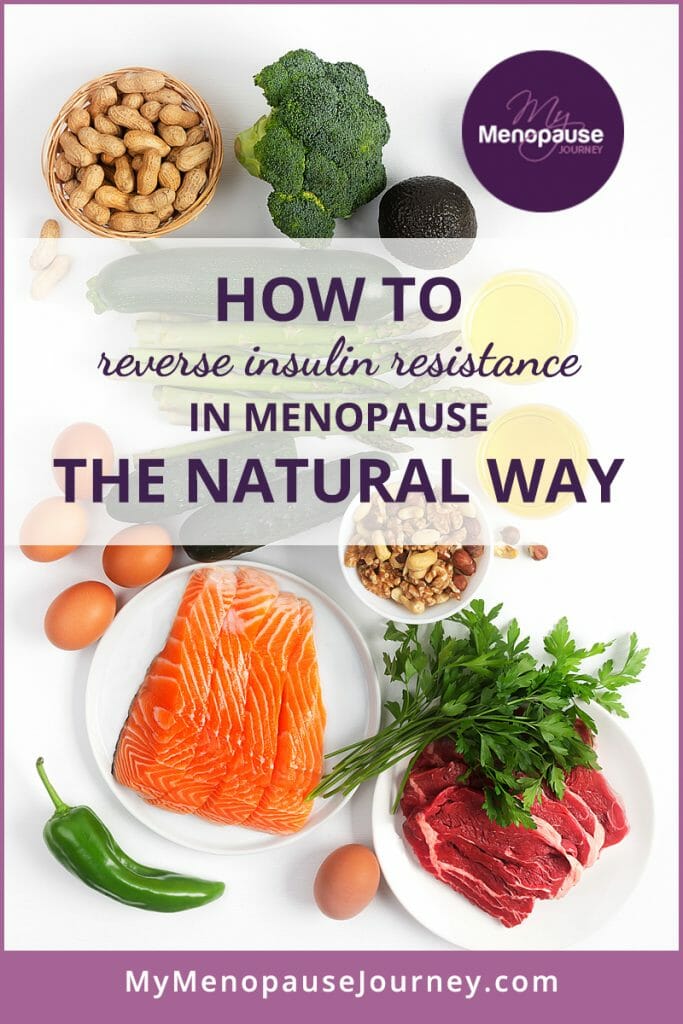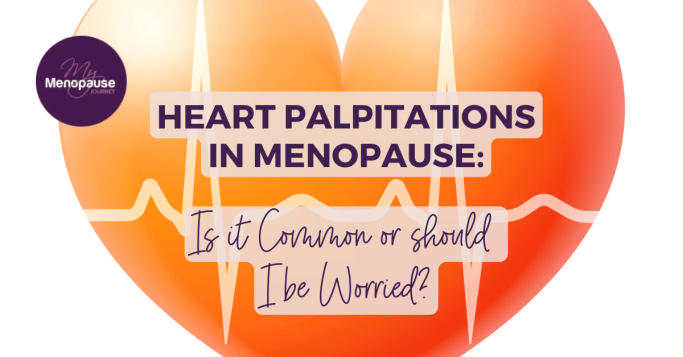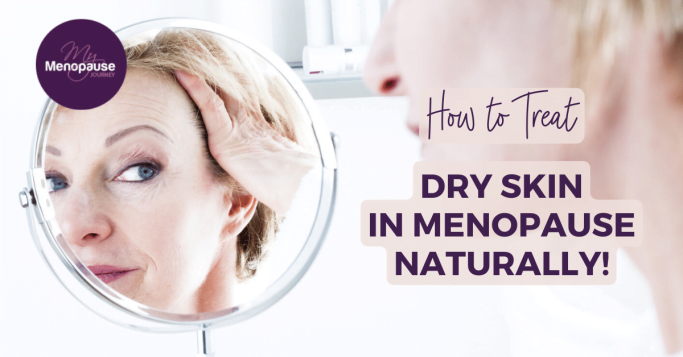Balance your sugar levels, regain your energy, ease fatigue, lose weight naturally and feel extra fresh throughout the day by learning how to reverse insulin resistance!
In menopause, it’s not just the rise and fall of your hormones that cause fatigue. Insulin resistance, which is a common condition during the transition, is also one culprit. The symptoms of insulin resistance are so similar to menopause that it can be challenging to set them apart.
According to experts, many Americans are tired during the day, because a whopping 25% of them have insulin resistance!
The good news for all of us is – there are so many ways to reverse this condition! But first, what’s this condition all about?
Let’s chat about it more, including insulin’s job in your body, how it can affect menopause, a list of insulin resistance symptoms and how to reverse insulin resistance for good!


What’s the Role of Insulin in the Body?
Insulin is a hormone made by your pancreas. Its main job is to help your body convert glucose (or sugar) into energy. When you eat, your blood sugar level goes up. Your pancreas then releases insulin so that it can transport glucose from your food into your body cells.
Some of your glucose also gets absorbed in your muscles, fats and liver. Your liver is the main storage of insulin. When glucose gets inside your liver (through the help of insulin), it turns glucose into glycogen for future use.
Insulin also has other interesting contributions to your body. It helps store and burn fats, absorb nutrients, improve cognition and control hunger together with leptin and ghrelin.
Dr. Berg has a good video about insulin and what it does in your body that you can watch [7:59]:
7 Top Causes of Insulin Resistance during Menopause
Insulin resistance happens when you have trouble transporting glucose into your cells. This may be caused by insulin overload, which makes your cells numb or unresponsive to insulin. Instead of getting absorbed in your cells, glucose stays in your blood, leading to elevated sugar levels. You might be wondering why this happens. Here are some causes:
1. Stress – a little stress here and there is alright, but when you have chronic stress, cortisol is always elevated. High cortisol also ups your insulin levels.
2. Too many carbohydrates – consumption of high-carbohydrate foods will cause sugar overload inside the body. To get rid of excess sugar, the pancreas releases insulin to transport the sugar into your cells. Over time, your cells will become insensitive to insulin, and they will resist its actions. As a result, sugar, and insulin stay in your bloodstream.
3. Too much sugar – habitual sugar consumption makes the pancreas work harder to produce insulin. And similar to eating too many carbs, your cells will eventually get tired of taking in insulin, leading to resistance.
We know sugar increases #insulin, but even by itself sugar is bad for you. – Ron RosedaleClick To Tweet4. Lack of physical activity – this makes your muscles dormant and as mentioned, glucose is stored in your muscles.
5. Overload of toxins – your food, water, the air you breathe, products you use in and around your homes, personal care products and the environment all have pollutants, chemicals and toxins. They bind with receptors in your cells and block them so they can’t respond to insulin.
6. Low thyroid function – thyroid hormones play a major role in glucose metabolism. When you have a low functioning thyroid gland, it slows down glucose absorption in your cells, it hinders the gut from absorbing glucose, slows down the response of your pancreas and decreases the clearance of insulin in your bloodstream.
7. Chronic inflammation – cellular inflammation caused by food, underlying infections, poor gut health, chronic stress and excessive use of over-the-counter medicines can decrease the responsiveness of your cells from insulin.
Aside from all these causes, one of the major reasons why you have insulin resistance during menopause is hormonal imbalance. During perimenopause, you may experience estrogen dominance (ED). ED can cause insulin resistance symptoms in many ways:
- High estrogen levels stimulate your pancreas to produce more insulin.
- High estrogen increases cortisol levels which also ups insulin levels.
- Low progesterone impairs the sensitivity of your cells and muscles to insulin.
- Low progesterone (has anti-inflammatory effects) increases the risk of inflammation.
So, is it good to have low estrogen then? The answer is no!
In the later parts of menopause, when estrogen levels start to decline, your pancreas slows its production of insulin. Because of low insulin, your liver is going to release all its stored glucose. Low estrogen can also cause widespread cellular inflammation, which can lead to insulin resistance symptoms.
While menopause contributes to insulin resistance, it can also be the other way around. When insulin is a mess, it may worsen the symptoms of menopause, especially hot flashes and night sweats. Insulin resistance also causes stubborn fats, which makes it harder to lose weight.
Most Common Insulin Resistance Symptoms
Insulin resistance doesn’t have symptoms right away. Symptoms usually start to appear when you have persistent high sugar levels. Here are some of them:
- Excessive thirst
- Lethargy
- Frequent urination
- Hunger
- Brain fog
- Belly fat
- High blood pressure
Apart from these insulin resistance symptoms, you may have acne breakouts. Excessive insulin stimulates the overproduction of your sebum, the oil that lubricates the skin. Hair loss happens because insulin helps regulate hair growth.
Swelling in your ankle and other body parts is common because insulin instructs the kidneys when to retain and flush out sodium and water.
Although it sounds counter-intuitive, you may also experience carbohydrate and sweet cravings. This is because your body can’t convert excess glucose into energy. The excess glucose stays in your blood, depriving your cells of energy. Your body will then signal to your brain that it needs more energy, and the quickest way to get it is through carbs and sweets. For this reason, you’ll experience a relentless desire to eat, even though you’re not really hungry.
Insulin resistance may lead to a string of problems like hypertension, heart disease and diabetes. It also makes aging faster.
Insulin resistance is the basis of all chronic diseases of aging because the disease itself is aging. – Ron RosedaleClick To TweetHow to Reverse Insulin Resistance in 10 Best Ways!
1. Eat a Paleo/Keto/LCHF diet. Experts say that weight loss makes your cells respond to insulin better. Decrease carbohydrate intake and replace carbs with plant-based sources like sweet potatoes and leafy greens. Eat more plant-based fats like avocado, edamame, sunflower seeds, Chia seeds and nuts.
2. Zero sugar. Avoid eating low-calorie or low-fat products because they have plenty of sugar mimickers like sucrose, glucose, high-fructose corn syrup and monosodium glutamate.
3. Eat more dietary potassium. Potassium helps regulate excess sugar in your body and efficiently stores them. Some of the best sources of potassium include avocado, acorn squash, spinach, sweet potato, wild-caught salmon and more! You read more about these potassium-rich foods in Dr. Axe’s article.
4. Lower your cravings. Salads with cruciferous and leafy greens, healthy fats and oils, like avocado, can help curb cravings. You can also grab a smoothie and add some seeds and nuts. They are high in fiber which means they can leave you satisfied for longer periods! Adding healthy fats into your diet like coconut oil, olive oil, butter and ghee will also help you feel full longer.
5. Get more vitamin B12! One of the best sources of B12 is nutritional yeast. B12 helps flush out excess insulin.
6. Do strength training and HIIT. Fitness experts say these exercises are highly effective in stimulating your muscles to contract and burn fats. These exercises also help sensitize your body to insulin.
7. Intermittent fasting. The longer you go without food, the more you will be able to decrease insulin. In addition, you will also be able to tap on excess fats for energy. You can start with 12 to 14 hours fast. Read more about intermittent fasting to see what method fits you!
8. Stress less. Declutter your life, do yoga and meditation and learn to delegate things you don’t need. Stress increases cortisol and insulin which worsens insulin resistance.
9. Consider using natural progesterone cream. Aside from balancing your hormone, natural progesterone may also help activate your body’s anti-inflammatory markers. It can stimulate the release of powerful antioxidants, like glutathione, and activate your GABA, which calms your body and improves mood.
10. Start your day with a keto coffee! Brew organic coffee, blend in and add grass-fed butter or ghee. You can also add coconut oil or MCT oil if you want. Coffee has the ability to wash out excess glucose in your blood.
Here’s another video by Dr. Berg (obviously he’s a favorite) where he simply explains insulin resistance. He also suggests some things you can do to avoid triggering insulin and how to reverse insulin resistance [11:45]:
More about How to Reverse Insulin Resistance!
Insulin resistance symptoms can be confusing, but there are many ways to reverse it. Dr. Christiane Northrup, a hormone expert suggests having your fasting insulin and cholesterol levels checked. You can also measure your hip-to-waist ratio or do a skin test. A skin condition called acanthosis nigricans is associated with insulin resistance.
Testing your hormones will also help you find out the root cause of your insulin resistance. There are many self-test kits that will help you check the levels of your cortisol, insulin, estrogen, progesterone, thyroid hormones and more. Read more about them in our article menopause tests.
When your body is in balance, your metabolic pathways work perfectly. Your body makes insulin when it needs to, slows down insulin when you’re starving and reduces your stored sugar when you have plenty.
But with modern life, exposure to long-term stress and our appetite for feasts and food, insulin resistance has become an all too common condition. But the good news is, insulin resistance is not a permanent condition, and we can feel better again!
Insulin resistance can be a tricky subject, share this article on Facebook, Twitter and Pinterest to debug confusion!
References:
www.menopausecentre.com.au/information-centre/articles/struggling-to-lose-weight/
www.diabetes.co.uk/insulin-resistance.html
www.drnorthrup.com/insulin-resistance-symptoms-mid-life/
www.stephaniedodier.com/a-major-cause-of-menopause-symptoms/
draxe.com/insulin-resistance-diet/
www.progesterone-info.com/insulin-resistance.html
www.restartmed.com/hypothyroidism-insulin-resistance/





Gita is the founder of My Menopause Journey. Since 2014, she has been supporting midlife women by sharing hard-earned learnings from her own experience. To advance her knowledge, Gita puts a lot of her time and effort into understanding the broad spectrum of women’s health. She immerses in extensive research about the physical, mental and emotional aspects of menopause. Gita believes in the life-changing power of healthy, holistic living — this is where she anchors her message to all women. Learn more about her marvelous mission in About us - My Menopause Journey.